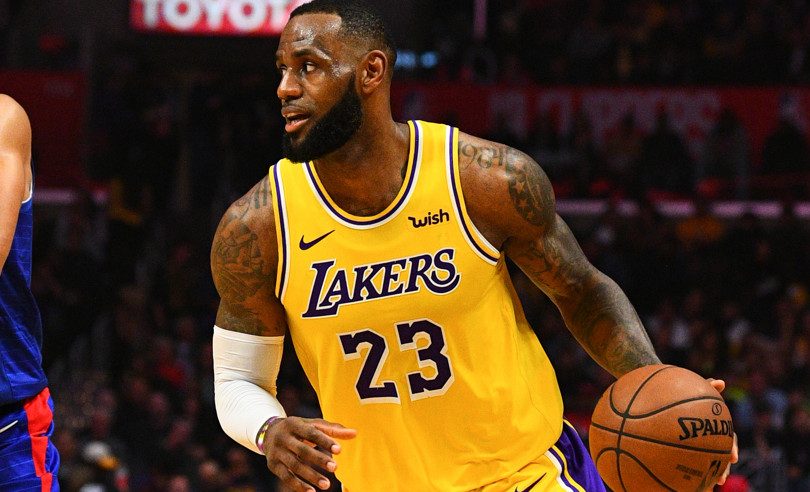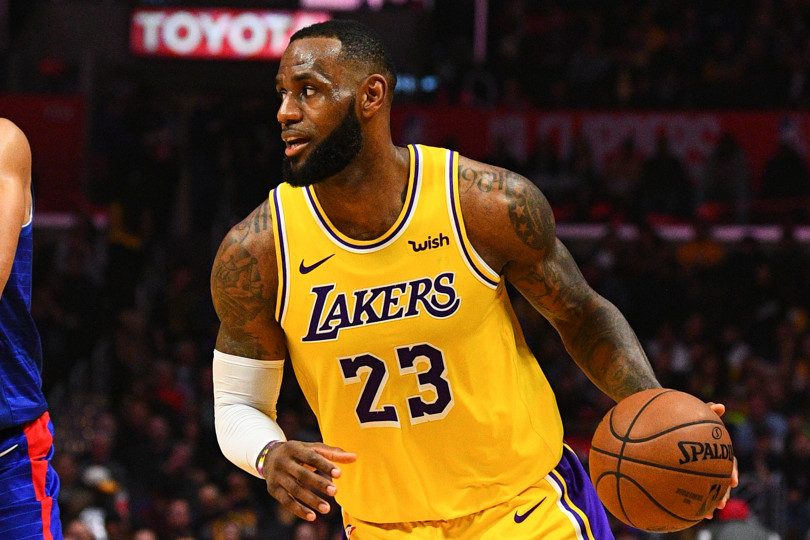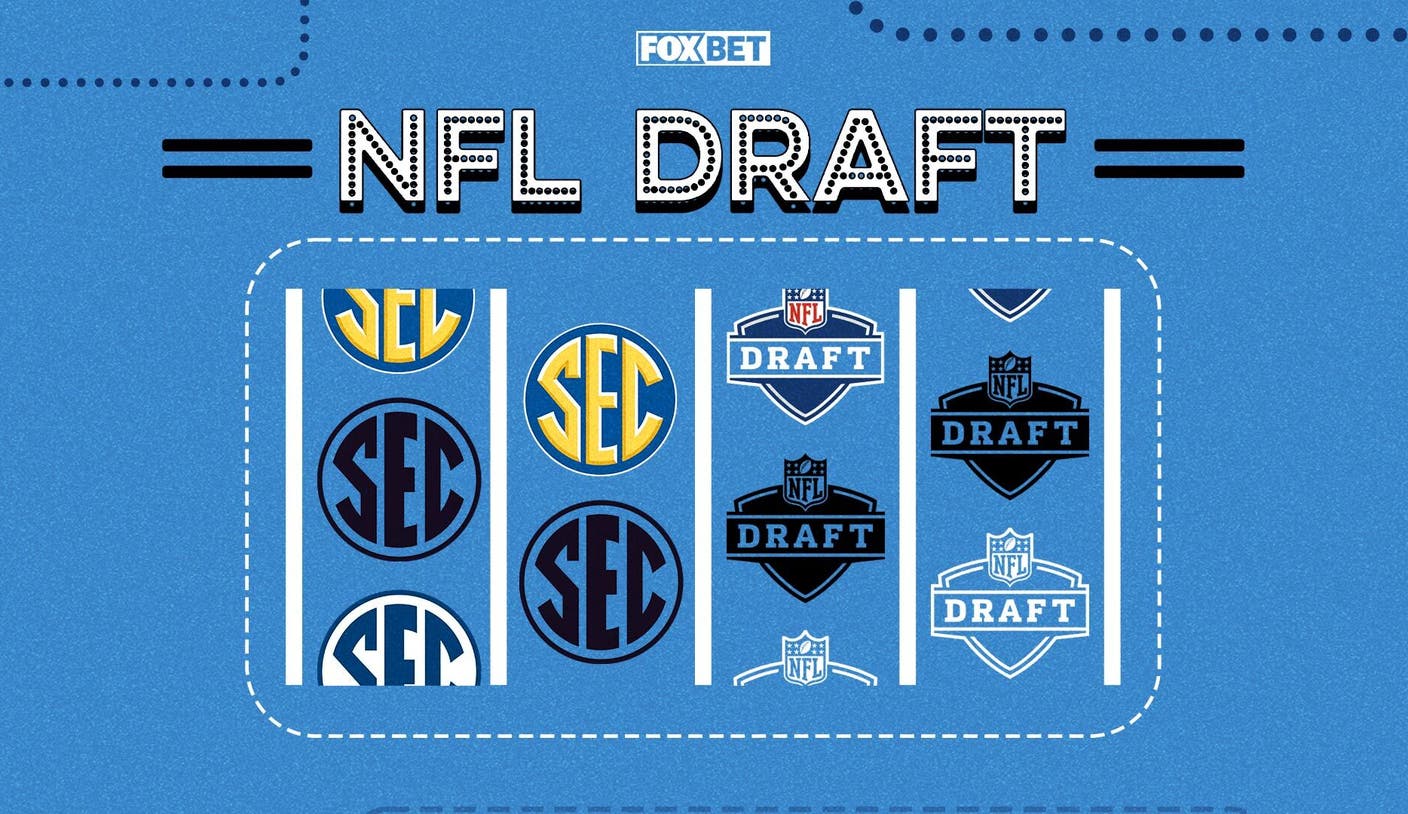How TeamRankings Has Prepared For The Return Of Sports
July 22, 2020 – by Jason Lisk

LeBron is hoping the second time is the charm in a Lakers uniform (Photo by Brian Rothmuller/Icon Sportswire)
The coronavirus pandemic threw quite a curveball at most sports related businesses, TeamRankings included.
What does a website like ours do when sports are halted, and we’re confronted with all sorts of uncertainty that we didn’t anticipate? For example:
When is a sport going to resume exactly?What may change when it resumes?Will there be further interruptions once it starts?Which teams and players will even end up playing?
For us, the answer has been to work on improving our site, models, and systems to handle these uncertainties in the best way we can.
The past several months have been a weird time, to say the least, and the sports world is still not out of the woods. But with MLB set to start Thursday and NBA following next week, there is some light on the proverbial horizon.
Dealing With An Uncertain Sports Landscape In 2020
Content:
ToggleThere’s no reason to sugar coat it: We are in uncharted waters right now, and we’re not sure how some of the pandemic-related changes will affect various features of TeamRankings.
For instance, the NBA’s current restart plan — a shortened season played in a neutral site “bubble” with a novel scheduling format — is unlike anything our predictive models have ever seen. We have little relevant historical data, and we don’t know what the impact on our future prediction accuracy for NBA will be.
With that said, we’ve been conducting various analyses and making what we believe are logical preparations and adjustments from sport to sport.
Preparing for Schedule and Format Changes
As of mid July, if things go according to plan, we’re going to see several unusual season schedule formats:
The NBA will feature a shortened end to the regular season played in the “bubble” of Orlando, Florida, with not all teams participating. The NBA schedule for the final regular season games has been released.MLB plans to play 60 games per team, not even half of a normal season. The shortened MLB 2020 schedule was released on July 6.The NFL is currently planning on its full 16-game schedule, but also has built in several contingencies to its schedule to facilitate a delayed start to the 2020-21 season if necessary.College football likely faces the most uncertainty of all, and more than one conference has already announced plans to only play conference games in 2020.
(You can see our post covering likely return scenarios for various sports for some of the most recent news.)
Making Our Systems More Flexible
To handle these situations, we’ve been improving our systems to better handle varying possible season lengths, to account for the possibility that not all teams play, and to adjust for “all neutral site games” bubble scenarios like the NBA’s plan.
Going forward, it will be much easier for us to react to additional future schedule changes in any sport. In many cases, we’ll also be able to quickly update features like our season projections.
Looking Forward To Football
NFL and college football, meanwhile, could present their own issues in 2020.
College football may see a change in the number of teams participating, or radically alter its traditional scheduling for other reasons. In addition, some regions of the country could be in a different situation than others.
In the NFL, several scenarios could play out if the pandemic worsens in the future, including certain regular season weeks being postponed and moved from the beginning of the season to the end, and/or particular weeks being eliminated altogether and the season shortened.
The prospect of moving or eliminating an NFL week may not sound like a huge deal, but it forces us to do a lot of work to prepare for it. We have some complicated NFL-related code that simply wasn’t designed to automatically handle NFL Week 2 suddenly becoming NFL Week 17, or a specific NFL week being canceled on potentially short notice.
So we’re doing the work necessary to prepare products like our NFL Survivor Picks and Football Pick’em Picks to be ready for atypical season formats, including potential mid-season interruptions.
Expanded Playoff Format Support
The NFL already announced one playoff format change this offseason, adding a 7th playoff team to each conference. We have updated our season projections and playoff odds models to account for that change, and it will be incorporated into our upcoming 2020 NFL preseason projections.
The potential for a shortened 2020 NFL season also increases the odds of further playoff changes, such as adding even more playoff teams.
Anticipating this possibility, we’re making our code that handles playoff and tournament projections more dynamic. These improvements will enable us to handle a wide variety of potential future alterations to playoff formats across sports.
For example, we will now be able to quickly handle the NFL going to an 8th playoff team in each conference this year (as it did in the strike-shortened 1982 season) or MLB adding an extra round to the playoffs (although that’s not currently the plan).
But There Is A Limit To What Makes Sense…
At the same time, some playoff format changes may end up being too strange or unusual for us to handle them without a huge amount of effort. In the end, these changes may not even be that important, so we may take shortcuts to account for them.
Take the NBA’s 8th and 9th playoff seed solution this year. If the No. 9 team in each conference finishes within four games of the No. 8 team in the final standings, the No. 8 and No. 9 seed will meet in a play-in round of up to two games. If there is a play-in situation, the No. 9 seed must win two straight games against the No. 8 seed to advance to the playoffs. The No. 8 seed will advance if it wins any one game.
A structure like that is complicated, and unique enough that we may never see it again.
In terms of allocating our constrained resources, getting ready for football season ranks higher than spending a lot of time and effort reworking our NBA projections code to precisely handle a quirky conditional playoff round — especially one that will likely exist for one season only.
In addition, the end result of handling it perfectly will simply be a slightly more accurate prediction of which team will likely lose to the No. 1 seed in the first round of the playoffs.
In such a case, we may just implement a rough logical adjustment to our playoff odds model to account for the fact that the No. 8 seed is no longer 100% guaranteed to make the playoffs, and move on.
Preparing for Increased Player-Level Uncertainty
Beyond league-level uncertainties, we also have to deal with how specific teams may be more or less affected by pandemic-related impacts.
For example, certain players may be absent for part 0f the season if they test positive for coronavirus, while other players may opt out of playing entirely.
Potential Player Absences From Positive Coronavirus Tests
One factor we initially thought might have a big impact is a team losing one or more key players to a positive coronavirus test.
(As a side note, we have not used player-specific data in our game prediction models in the past, with the exception of MLB starting pitcher data. That will likely change in the future.)
After more research, we ultimately determined that the risk of unanticipated player absences did not warrant a major adjustment to our team ratings or predictive models. If you want a deeper explanation, you can read more about it in a detailed post on the topic.
Uncertainty Due to Time Delay
Another source of uncertainty is what happens when there is significant time off in between games.
This factor applies most specifically to the NBA, which will restart play following a nearly four-month delay. It could also come up in the NFL, if play ends up being suspended mid-season and resumed later.
To investigate the potential impact of this factor on the NBA, we analyzed the variance of the margin of victory projections made by our historical team power ratings for future games. Specifically, we looked at how the error in those predictions changed over time.
The quick (and probably unsurprising) summary: the farther in the future a game is, the less accurate current team ratings are at predicting the outcome of that game.
As a result, we expect that our team predictive ratings from back in March, as of the day the NBA season was suspended, will be slightly less accurate when games restart this summer than they would have been back in March. So for the NBA restart, we are slightly regressing all of our pre-suspension NBA team ratings toward the league average.
Translation: on Return Day 1, we won’t expect good teams to be quite so good as they were back in March, or bad teams to be quite so bad.
With other sports, we will employ a wait-and-see approach specific to the sport, using whatever relevant data we think might make sense. For example, the 1982 NFL season had a nearly two-month delay due to a player strike, before returning to play. The 1987 NFL season featured a 4-week lockout, with games played by replacement players before the regular players returned.
If the NFL has mid-season suspension this year, we’ll examine those past stoppages in more detail.
Uncertainty of No Fans or Reduced Crowds
We have also researched how differing crowd conditions and game venues should impact our projections. Our home field advantage (HFA) research, and early betting lines for the 2020 NFL season, both seem to support the position that an absence of crowds should not make a huge difference in the NFL. You can read our summary of NFL home field advantage in this post.
The NBA plans to play neutral site games in Orlando with no crowds. Neither team will have a home advantage (or a road disadvantage) and travel effects will not exist. This will have an impact on playoff series, which lower seeded teams will have a slightly higher chance of winning this year, because higher seeded teams will no longer have a home court advantage.
Finally, we’ve spent time looking at our MLB home field data and reviewing the accuracy of our past game predictions. Our team predictive ratings have been pretty solid at forecasting wins and losses, but they’ve done worse on margin of victory projections. We realized some refinements we could make to better account for the impact of home teams in the lead not batting in bottom of the 9th inning, and made some corresponding adjustments to our MLB ratings.
What’s Next For TeamRankings
At long last, sports are coming back, but how they proceed for the rest of 2020 is still not entirely certain. No one has proven to be particularly adept at predicting the future of the pandemic, and it’s still not exactly clear how effective the protective measures of the various US pro and college leagues will be.
This environment continues to pose challenges for a site like TeamRankings, but we’re working to prepare for whatever the future may hold — and most importantly, to continue to deliver the data-driven edge that our subscribers expect. Our NBA and MLB prediction models are back up and running for upcoming games, along with popular content such as our odds pages, matchup pages, and season projections.
Last but not least, we were able to carve out some time over the past several months to work on some new features and content for football season, which we are excited to release in the weeks ahead. Welcome back to the site!
If you liked this post, please share it. Thank you! Twitter Facebook
NFL Football Pool Picks NFL Survivor Pool Picks NCAA Bracket Picks College Bowl Pool Picks College Football Pool Picks NFL Picks NBA Picks MLB Picks College Football Picks College Basketball Picks NFL Predictions NBA Predictions MLB Predictions College Football Predictions College Basketball Predictions NFL Spread Picks NBA Spread Picks MLB Spread Picks College Football Spread Picks College Basketball Spread Picks NFL Rankings NBA Rankings MLB Rankings College Football Rankings College Basketball Rankings NFL Stats NBA Stats MLB Stats College Football Stats College Basketball Stats NFL Odds NBA Odds MLB Odds College Football Odds College Basketball Odds A product ofTeamRankings BlogAboutTeamJobsContact
© 2005-2024 Team Rankings, LLC. All Rights Reserved. Statistical data provided by Gracenote.
TeamRankings.com is not affiliated with the National Collegiate Athletic Association (NCAA®) or March Madness Athletic Association, neither of which has supplied, reviewed, approved or endorsed the material on this site. TeamRankings.com is solely responsible for this site but makes no guarantee about the accuracy or completeness of the information herein.
Terms of ServicePrivacy Policy



